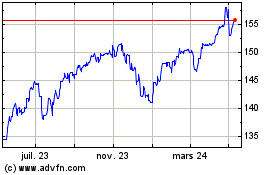Dollar Recovers After U.S. GDP Data
26 Janvier 2018 - 10:55AM
RTTF2
The U.S. dollar erased its early losses against its major
counterparts in the European session on Friday, as the U.S.
economic growth steadied in the fourth quarter and the U.S.
President Donald Trump remarked that he favors a strong
currency.
Data from the Commerce Department showed that real gross
domestic product increased by 2.6 percent in the fourth quarter
compared to the 3.2 percent growth seen in the third quarter.
Economists had expected GDP to climb by 3.0 percent.
Data from the Commerce Department showed a substantial increase
in new orders for U.S. manufactured durable goods in the month of
December.
The Commerce Department said durable goods orders spiked by 2.9
percent in December after surging up by an upwardly revised 1.7
percent in November.
The U.S. currency is on track to be stronger and stronger as the
nation is becoming strong again, Trump said in an interview from
the World Economic Forum in Davos, Switzerland.
"Our country is becoming so economically strong again — and
strong in other ways, too, by the way — that the dollar is going to
get stronger and stronger. And ultimately, I want to see a strong
dollar," he told.
The greenback rose back to 109.57 against the yen, off its early
low of 108.91. This may be compared to a 2-day high of 109.77 hit
at 7:15 pm ET. The greenback is seen finding resistance around the
111.00 region.
Data from the Ministry of Internal Affairs and Communications
showed that Japan consumer prices rose 1.0 percent on year in
December.
That was unchanged from the November reading, although it came
in beneath expectations for a gain of 1.1 percent.
The greenback staged a brief recovery to 0.9364 against the
franc, off its prior low of 0.9328. If the greenback rises further,
0.95 is likely seen as its next resistance level.
The greenback bounced off to 1.2422 against the euro, from a low
of 1.2493 hit at 2:45 am ET. The greenback is seen finding
resistance around the 1.23 region.
Survey of Professional Forecasters published by the European
Central Bank showed that the near term inflation is expected to
rise more than previously projected.
Forecasters raised their inflation outlook for 2018 to 1.5
percent from 1.4 percent. Likewise, the outlook for 2019 was lifted
to 1.7 percent from 1.6 percent. Inflation is seen at 1.8 percent
in 2020.
The greenback erased some of its early losses against the pound
with the pair trading at 1.4211. This may be compared to a low of
1.4281 hit at 4:30 am ET. The next possible resistance for the
greenback is seen around the 1.38 level.
The greenback reversed from an early low of 1.2301 against the
loonie, rising to 1.2360. Continuation of the greenback's uptrend
may see it challenging resistance around the 1.26 area.
The greenback recovered to 0.8061 against the aussie and 0.7324
against the kiwi, from its early lows of 0.8097 and 0.7375,
respectively. The currency is thus heading to pierce its multi-day
highs of 0.8005 and 0.7291,respectively hit against the aussie and
the kiwi in the Asian session. On the upside, 0.78 and 0.72 are
possibly seen as the next resistance levels for the greenback
against the aussie and the kiwi, respectively.
US Dollar vs Yen (FX:USDJPY)
Graphique Historique de la Devise
De Mar 2024 à Avr 2024

US Dollar vs Yen (FX:USDJPY)
Graphique Historique de la Devise
De Avr 2023 à Avr 2024
